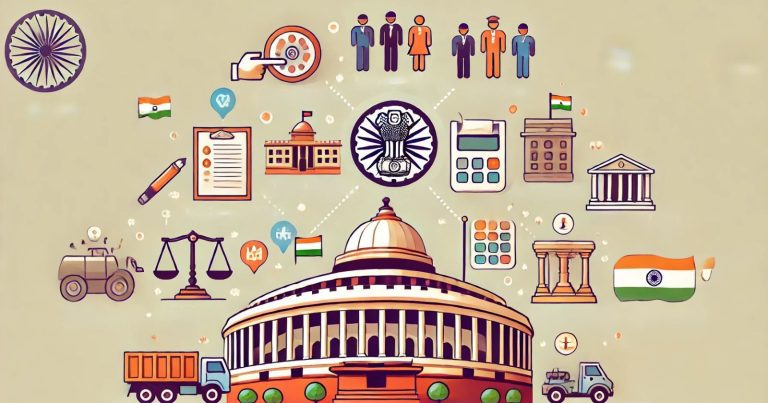Government is the organised system with laws to maintain order in society, provide services for public welfare, and run a country or state, state or local community. Policies ensure stability at the country and state levels when running a society. Governments occur at different levels and in multiple forms depending on how a country is organised. The role of the government is not only in making laws but also in defence, economic growth, public welfare, and international relations.
What is Meant by Government?
A system or group of people responsible for making and enforcing laws, maintaining order, and managing public resources is called government. The rationale behind government is to ensure society operates efficiently by providing security, justice, and welfare. There are three kinds of governments: democratic, authoritarian, and mixed governments; the selection and distribution of power determine these. They also work on different levels, such as local, state, and central, to efficiently run different phases of life.
Functions of Government
The government needs to perform various critical functions for the country to function appropriately. It gives and mandated rules to ensure peace and safety between its citizens. They ensure that nothing is unfair and fight against war to provide a safe and just environment. They are responsible for defence and security — they must protect their nation from enemies from outside and inside. Governments help their people to live without fear and uncertainty, thus ensuring peace and stability.
Governments also deliver public services that enhance the lives of citizens — education, health care and much more. They control the economy by controlling industries which lead to job creation that further enhances the economy. Social welfare and equal opportunities are the other essential responsibilities governments have to take care of to offer facilities for economically backward citizens. Though governments may vary in structure worldwide, the ultimate objective remains the same and looks forward to promoting peace, progress, and justice among all citizens.
Responsibilities of Government
Governments must ensure that they assist the people to attain stability, growth, and justice. It has to create an environment whereby citizens can live safely and prosperously. If a government is ineffective, society will have no order, development, or justice. Government responsibilities affect every citizen’s life, hence facilitating smooth governance.
- Ensuring Law and Order: The government implements laws that provide peace and protect people from crime. Police, courts, and other security forces are part of the government to deal with justice and stop unauthorised and illegal activities. Governments also determine punishments for wrongdoings to enforce discipline and secure a place to live for all.
- Providing Public Services: The provision of public services, which the government does to enhance public life. Such provision involves creating roads, hospitals, and schools. Governments also strive to ensure clean water, electricity, and sanitation. Governments must also introduce welfare programs into each citizen’s health, education, and social development.
- Economic Development and Employment: They design policies to expand the scale of industries and trade to grow the business. Governments provide employment and make funding available for companies to enhance economic development. More investment is done in infrastructural and technological development to provide more opportunities and to strengthen the country’s economy.
- Defending the Nation: It provides defence to the nation with the help of the army, navy, and air force. This government maintains the nation’s security and oversees international relations so there will be peace worldwide. The government prepares a defence strategy; modern equipment is provided to the forces for citizens’ protection.
- Tax collection and resource management: The money paid in terms of taxes is directed to various public infrastructures and amenities like roads, schools, or healthcare. Governments use all their resources judiciously to evade the reoccurrence of any economic disintegrations and achievement of fiscal policy. The governments also formulates the laws and policies which help in controlling the spending hence promoting a robust and stable economy.
- Protecting Rights and Freedom: Governments oversee the courts of law and enforces justice. It provides rights like freedom of speech and other fundamental rights to avoid marginalization and discrimination. The policies in relation to the administration is made to enforce democracy that everyone’s say is heard in the rapacious of the government.
Levels of Government
The government functions at multiple levels to successfully handle different types of responsibilities. In India and most countries, the three main levels are the local, state, central, or national governments.
Local Government
The local authority operates public services at a village, town, or city level. Panchayats govern villages, while cities and towns fall under Municipalities, which deal with administration. These local organisations ensure that amenities such as drinking water, solid waste collection and disposal, and street lighting, among others, run efficiently for locals.
Local governments also prioritise developing public spaces such as parks, markets, and community centres. They ensure good sanitation, drainage, and road maintenance for a clean and safe environment. Being closer to the people, local governments understand the community’s needs more and solve problems quickly to improve everyday life.
State Government
The state or provincial government performs within a certain state or province and runs critical public services. The Chief Minister heads the state government and ministers run different departments. State governments control law and order, schools, hospitals, and transport, catering to citizen welfare.
State governments state highways, public hospitals, and government schools to administer services to people. They also carry out the implementation of welfare schemes, management of agriculture, and maintaining law and order in society. Country running is quite smooth with the cooperation of state, central, and local governments.
Central (National) Government
The central government is the highest governing body that rules the country. It controls the whole country, and the Prime Minister and President form the central government that governs the country. They decide important matters concerning the country. It has concerns over defence, foreign relations, national laws, and the country’s overall economic policy.
The central government oversees the railways, national highways, and mega-infrastructure development projects for national growth. It develops national policies on security, trade, and international issues to ensure the support of the nation across the globe. Central government coordination is high as well with mutual coordination with the state and local government, allowing for effective nation management.
Forms of Government
Governments come in different shapes, with distinctions based on how leaders are selected and how power is allocated. There are three main types of Government:
Monarchy
A monarchy is a government where a king, queen, or emperor rules the country. The ruler is known as a monarch, usually inheriting power from his family. Monarchs may have total control over the government or share power with elected officials. Most monarchies, such as the United Kingdom, are constitutional, meaning laws restrict the powers of the ruler.
In absolute monarchies, decision-making is given to the king or queen without the people’s opinion. However, in modern times, most monarchies work with a parliament or government to pass laws and make decisions. Monarchs, therefore, symbolise tradition, national identity, and leadership passing from generation to generation.
Oligarchy or Aristocracy
An oligarchy is where a small group of influential people controls the country. They are usually rich, influential, or extremely powerful in the military ranks. Decisions are based on their benefits rather than the general population’s. Ancient Sparta was an oligarchic state where a few rulers controlled the government.
An aristocracy is an oligarchy in which noble families have the power. The aristocrats were born to positions and thought they were better because of their wealth and social standing. This form of government limits the opportunities for the commoners and keeps power in a few aristocratic families’ hands. Today, even democratic nations’ economies and politics are influenced by oligarchies.
Democracy
A democracy is a government where the citizens elect their leaders and participate in decision-making. People vote in elections to choose representatives who create laws and run the country. Democratic governments protect human rights, freedom of speech, and equality. Countries like India and the United States follow a democratic system.
There are two major forms of democracy: direct democracy and representative democracy. In the former, citizens vote on each law and policy, while elected representatives make decisions for the people in the latter. The democracies encourage their parties to provide just governance, responsibility, and citizenship participation in government matters.
Dictatorship
A dictatorship refers to a system of government where one man exercises absolute power and controls all spheres of life. He makes laws, commands the army, and imposes his will on people’s lives. Dictators typically remain in power for long periods and do not allow elections or opposition. Adolf Hitler of Germany and Joseph Stalin of the Soviet Union are good illustrations.
Most dictators use fear and military might to maintain power. People are not allowed to speak freely nor criticise the government. They claim to have brought stability when, in actuality, human rights violations are common, and democracy is suppressed. Some dictatorships also control the media to disseminate propaganda and limit access to information.
Autocracy
An autocracy is a system whereby one person possesses unlimited power, making all the decisions without reference to others. The leader of such a government is called an autocrat; he does not share power with a parliament or government officials. In contrast with a democracy, citizens have no say in the running of their country. Famous examples of an autocracy are North Korea and the historical empires of Tsarist Russia.
Autocrats, with their robust control over the military and the use of censorship to limit freedom, maintain their dominance through restrictive free speech, stopping protests, and control of the press, thus outlawing all opposition. Most autocrats claim to maintain order, but their rule leads to corruption and inequality of personal freedoms for citizens.
Government FAQs
1. What is coalition government?
It is a type of government where different political parties join hands because no political party enjoys its majority.
2. What is parliamentary government?
A situation in which executives depend upon the legislature and elected representatives formulate all the policies for the government headed by the Prime Minister.
3. What is an alliance government?
An alliance government is established when two or more political parties combine with a common objective; it is usually done to compete for elections or to form a government together.
4. How is a government different from an administration?
A government is the establishment of the making of laws and their rules, whereas administration refers to the officials and their departments that implement these very laws.
5. Why do we need a government?
A government preserves law and order, provides public services, ensures national security, and manages economic growth. It enforces a structured society where the people can live peacefully and prosper in its soil.


